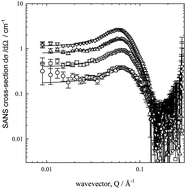A contrast variation small-angle scattering study of the microstructure of 2,5-dimethyl-7-hydroxy-2,5-diazaheptadecane–toluene–butanol oil-in-water metallomicroemulsions†
Abstract
Metallosurfactants comprising

* Corresponding authors
a
School of Chemistry, Cardiff University, Main Building, Park Place, Cardiff, UK
E-mail:
paula3@cardiff.ac.uk
Fax: +44 (0)2920 874030
Tel: +44 (0)2920 870419
b School of Optometry and Vision Sciences, Cardiff University, Maindy Road, Cathays, Cardiff, UK
c Science and Technology Facilities Council, ISIS Facility, Rutherford Appleton Laboratory, Didcot, Oxfordshire, UK
Metallosurfactants comprising

 Please wait while we load your content...
Something went wrong. Try again?
Please wait while we load your content...
Something went wrong. Try again?
A. Paul, I. Fallis, C. Cooper, T. Wess, K. Thomas, R. Heenan, S. King and P. Griffiths, Soft Matter, 2010, 6, 2552 DOI: 10.1039/B926812J
To request permission to reproduce material from this article, please go to the Copyright Clearance Center request page.
If you are an author contributing to an RSC publication, you do not need to request permission provided correct acknowledgement is given.
If you are the author of this article, you do not need to request permission to reproduce figures and diagrams provided correct acknowledgement is given. If you want to reproduce the whole article in a third-party publication (excluding your thesis/dissertation for which permission is not required) please go to the Copyright Clearance Center request page.
Read more about how to correctly acknowledge RSC content.
 Fetching data from CrossRef.
Fetching data from CrossRef.
This may take some time to load.
Loading related content
